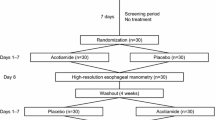Abstract
The effect of cimetropium bromide, a new anticholinergic agent, in patients with primary achalasia was studied. Twenty such patients (12 females and 8 males, mean age 38 years, range 15–56) were studied. Diagnosis was performed by radiology, endoscopy, and manometry. Lower esophageal sphincter pressure and body wave amplitude were measured by means of a five-channel catheter constantly perfused by a low-compliance pneumohydraulic pump. Patient received cimetropium bromide 10 mg intravenously over 3 min or placebo in a double-blind manner. In five patients esophageal transit evaluated by scintiscanning was studied on separate occasions after cimetropium bromide or placebo. Baseline mean lower esophageal sphincter pressure was 46±5 mm Hg and mean amplitude of body waves was 30±8 mm Hg. Cimetropium bromide induced a significant decrease in sphincter pressure and body wave amplitude that measured 13±3 mm Hg and 8±4 mm Hg, respectively, 15 min after the end of infusion. The decrease was maintained for 45±5 min. A marked reduction in repetitive body waves was also noted. Esophageal transit was also accelerated with cimetropium bromide. Maximal stomach radioactivity was observed after 8±1.8 sec while with placebo this was reached after 65±1.5 sec (P<0.01). It is concluded that cimetropium bromide reduces LES pressure and shortens transit in primary esophageal achalasia. It may be useful in the treatment of this esophageal motility disorder.
Similar content being viewed by others
References
Traube M: On drugs and dilators for achalasia. Dig Dis Sci 36:257–259, 1991
Triadafilopulos G, Aaronson M, Sackel S, Burakoff R: Medical treatment of esophageal achalasia. Double-blind crossover study with oral nifedipine, verapamil, and placebo. Dig Dis Sci 36:260–267, 1991
Schiavone A, Schiavi GB, De Conti L, Micheletti R, Sagrada A, Hammer R, Giachetti A: Cimetropium: Characterization of antimuscarinic and spasmolytic properties. Arzneimforsch Drug Res 35:766–769, 1985
Sagrada A, Schiavone A, Cefalá, Micheletti R: Cimetropium bromide:In vitro andin vivo evaluation of spasmolytic activity on human and dog colon. Digestion 42:143–150, 1989
Marzio L, Pieramico O, Neri M, Delle Donne M, Dimitri A, Imbimbo BP, Cuccurullo F: Comparative study of the effects of cimetropium bromide and atropine on human esophageal motor functions. Digestion 44:117–123, 1989
Bassotti G, Gaburri M, Imbimbo PB, Betti C, Daniotti S, Pelli MA, Morelli A: Manometric evaluation of cimetropium bromide activity in patients with nutcracker oesophagus. Scand J Gastroenterol 23:1079–1084, 1988
Russell COH, Whelan G: Oesophageal manometry: How well does it predict oesophageal function. Gut 28:590–594, 1987
Dent J: A new technique for continuous sphincter pressure measurement. Gastroenterology 71:263–267, 1976
Daniel EE, Bowes KL, Duchon G: The structural basis for control of gastrointestinal motility in man.In Proceedings of the Fifth International Symposium on Gastrointestinal Motility. G Vantrappen (ed). Herentals, Belgium, Typoff Press, 1975, pp 142–151
Gilbert R, Rattan S, Goyal RK: Pharmacologic identification, activation and antagonism of two muscarine receptors subtypes in the lower esophageal sphincter. J Pharmacol Exp Ther 230:284–291, 1984
Holloway RH, Dodds WJ, Helm JF, Hogan WJ, Dent J, Arndorfer RC: Integrity of cholinergic innervation to the lower esophageal sphincter in achalasia. Gastroenterology 90:924–929, 1986
Tøttrup A, Forman A, Funch-Jensen P, Raundahl U, Andersson K-E: Effects of postganglionic nerve stimulation in oesophageal achalasia: anin vitro study. Gut 31:17–20, 1990
Goldenberg SP, Burrel M, Fette GG, Vos C, Traube M: Classic and vigorous achalasia: A comparison of manometric, radiographic, and clinical findings. Gastroenterology 101:743–748, 1991
Paterson WG, Hynna-Liepert TT, Seluky M: Comparison of primary and secondary esophageal peristalsis in humans: effect of atropine. Am J Physiol 260:G52-G57, 1991
Netscher D, Larson GM, Polk HC Jr: Radionuclide esophageal transit. A screening test for esophageal disorders. Arch Surg 121:843–848, 1986
Holloway RH, Lange RC, Plankey MW, McCallum RW: Detection of esophageal motor disorders by radionuclide transit studies. A reappraisal. Dig Dis Sci 34:905–912, 1989
Gelfond M, Rozen P, Gilat T: Isosorbide dinitrate and nifedipine treatment of achalasia: A clinical manometric and radionuclide evaluation. Gastroenterology 83:963–969, 1982
Imbimbo BP, Daniotti S, Vidi A, Foschi D, Saporiti F, Ferrante L: Discontinuous oral absorption of cimetropium bromide, a new antispasmodic drug. J Pharm Sci 75:680–684, 1986
Author information
Authors and Affiliations
Rights and permissions
About this article
Cite this article
Marzio, L., Grossi, L., DeLaurentiis, M.F. et al. Effect of cimetropium bromide on esophageal motility and transit in patients affected by primary achalasia. Digest Dis Sci 39, 1389–1394 (1994). https://doi.org/10.1007/BF02088038
Received:
Revised:
Accepted:
Issue Date:
DOI: https://doi.org/10.1007/BF02088038




